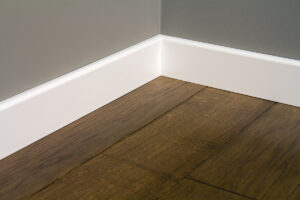
The differences between red oak and white oak make it worth considering both options.
Choosing the right type of wood flooring can elevate your home’s aesthetic and add long-lasting value. Two choices in hardwood flooring are Red Oak and White Oak. Both types of oak offer durability and beauty, but they differ in color, grain pattern, hardness, and maintenance needs. Understanding these differences will help you choose the flooring that best fits your lifestyle and design preferences.
Color Differences
One of the most noticeable differences between Red Oak and White Oak flooring is the color.
- Red Oak: True to its name, Red Oak has warm undertones that range from subtle pink to deep reddish hues. It brings warmth and richness to a room, especially when stained to enhance its natural color. Red Oak’s warm tones make it a popular choice for traditional and rustic interiors, adding a cozy feel to any space.
- White Oak: White Oak has more neutral undertones, with colors ranging from light beige to grayish-brown. This subtle color palette gives White Oak a contemporary look and allows it to pair well with modern and minimalist designs. Because of its versatility, White Oak works well with a wide range of stain colors, giving homeowners flexibility in matching different decor styles.
Grain Pattern
The grain pattern is another distinguishing factor between these two types of oak.
- Red Oak: Red Oak has a more prominent, defined grain pattern with swirling patterns and visible knots. Its distinct grain can add texture and character, making it a great option if you prefer flooring with a more traditional or rustic look. Red Oak’s grain pattern also helps to conceal small scratches and dents, which can be a plus for busy households with children or pets.
- White Oak: White Oak’s grain pattern is more subtle, with a straighter, more consistent appearance. This uniformity gives White Oak flooring a sleek, sophisticated look that suits modern and minimalist aesthetics. The tight grain structure also makes it ideal for larger spaces where a more refined, seamless look is desired.
Hardness and Durability
Both Red Oak and White Oak are durable and long-lasting, but White Oak has a slight edge in terms of hardness.
- Red Oak: With a Janka hardness rating of 1,290, Red Oak is resilient and holds up well to everyday wear and tear. It’s a popular choice for households with moderate traffic, as its forgiving grain pattern can help mask imperfections.
- White Oak: White Oak is slightly harder than Red Oak, with a Janka rating of 1,360. This added durability makes White Oak a better choice for high-traffic areas, such as entryways, hallways, and kitchens. Additionally, White Oak’s denser grain structure makes it slightly more resistant to moisture, which can be beneficial in humid climates or areas where there’s a higher chance of spills.
Stain and Finishing Options
Both Red Oak and White Oak respond well to stains, but they take stains differently due to their natural colors and grain patterns.
- Red Oak: Red Oak’s warm tones mean that it absorbs darker stains beautifully. However, its pinkish undertones can sometimes be challenging to neutralize if you’re aiming for a lighter or cooler finish. When stained, Red Oak tends to enhance its natural grain, which may appeal to those who like a more rustic or classic hardwood floor look.
- White Oak: White Oak is highly versatile and takes a wide variety of stains, from light to dark shades. Its neutral base color allows for a more uniform appearance, even with lighter or cooler stains. For those looking to achieve a contemporary look, White Oak is a great choice as it can handle gray or whitewash stains exceptionally well, creating an on-trend look without compromising the wood’s natural appeal.
Maintenance and Longevity
Both types of oak require regular maintenance to keep them looking their best, including sweeping, occasional dry or damp mopping, and periodic refinishing.
- Red Oak: Thanks to its grain pattern, Red Oak is less likely to show small scratches, dents, and other minor imperfections. Regular refinishing can keep Red Oak floors looking fresh and can add years to their lifespan.
- White Oak: White Oak’s denser grain structure and higher hardness make it more resistant to dents and scratches, which can be beneficial in homes with high foot traffic. However, due to its more uniform grain, scratches or blemishes may be more noticeable compared to Red Oak. As with Red Oak, refinishing can help maintain its longevity and appearance over time.
Hardwood Flooring from Jason Brown Wood Floors
At Jason Brown Wood Floors, our commitment to quality installation is clear in all that we do, which is why our customers consistently rate us as one of the top contractors in the region. We have been awarded Baltimore Magazine’s Best of Baltimore Award 5 times and have been proudly serving the Baltimore Area for over 18 years. If you’re ready to speak with someone about your hardwood flooring project, we want to hear from you! Contact us at 410-668-9131 or send us a message here.
Jason Brown Wood Floors is also your convenient dealer of high-quality, professional-grade power tools. We offer brands that tradespeople trust most for the job. Come check out our Abingdon showroom to browse the in-stock selection of products and tools by Festool, Freud, Diablo, Shaper, Mirka, Makita, Saw Stop, and Grex.
Keep up with us on Facebook, Twitter, Pinterest, Houzz, and YouTube, and check out our blog for more news and information!


